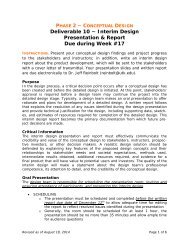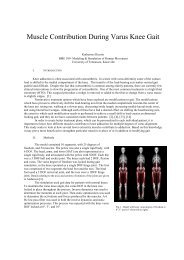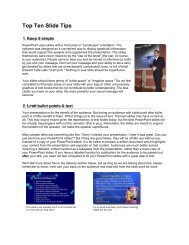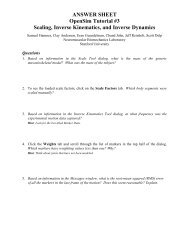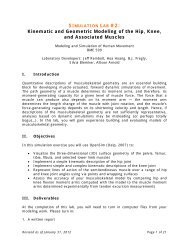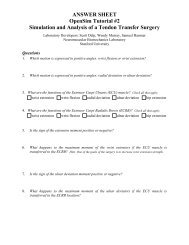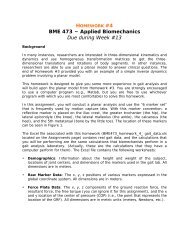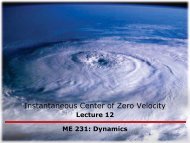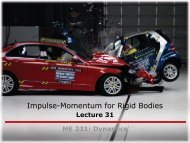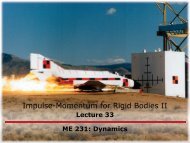Newton's 2nd Law for a Particle
Newton's 2nd Law for a Particle
Newton's 2nd Law for a Particle
Create successful ePaper yourself
Turn your PDF publications into a flip-book with our unique Google optimized e-Paper software.
Newton’s 2 nd <strong>Law</strong>Lecture 18ME 231: Dynamics
Question of the DayWhich defensive player generates thelargest tackling <strong>for</strong>ce?DB 5’-11” 203 lb (92 kg)4.35 s 40-yd dasha = 33.63 m/s 2ME 231: DynamicsLB 5’-10” 224 lb (101 kg)4.94 s 40-yd dasha = 29.60 m/s 22
Outline <strong>for</strong> Today Question of the day Kinetics: cause of motion Possible solutions to kinetics problems Force:acceleration ratio experiment Newton’s 2 nd <strong>Law</strong> <strong>for</strong> a particle Force and mass units Newton’s 2 nd <strong>Law</strong> <strong>for</strong> a system of particles Answer your questions!ME 231: Dynamics3
Where are we in the course?Concept: What is dynamics?Chapters 1, 2, 6 Chapters 3, 5, 7, 8Kinematics Kinetics DynamicsRelationshipamong position,velocity, andaccelerationRelationshipamong <strong>for</strong>ces(andmoments)andaccelerationME 231: Dynamics4
Kinetics: Cause of MotionConcept: What is kinetics?ME 231: Dynamics 5
Kinetics: Cause of MotionConcept: What is kinetics?ME 231: Dynamics 6
Kinetics: Cause of MotionConcept: What is kinetics?Kinetics: The study of the relationsbetween unbalanced <strong>for</strong>ces (andmoments) and the resulting changesin motion.ME 231: Dynamics 7
Kinetics: Cause of Motion?Concept: What is kinetics?ME 202Chapters 1, 2, 6 Chapters 3, 4, 5, 7, 8Statics Kinematics KineticsRelationshipamong <strong>for</strong>ces(and moments)and equilibriumRelationshipamong position,velocity, andaccelerationRelationshipamong <strong>for</strong>ces(andmoments)andaccelerationME 231: Dynamics8
Possible Solutions to Kinetics Problems Direct application of Newton’s <strong>2nd</strong> <strong>Law</strong>– <strong>for</strong>ce-mass-acceleration method– Chapters 3 and 7 Use of impulse and momentum methods– Chapters 5 and 8 Use of work and energy principles– Chapter 4ME 231: Dynamics9
Force:Acceleration Ratio Experiment Force:acceleration ratio is constant This constant is a measure of inertiaof the particle (resistance to rate ofchange in velocity) Acceleration in the direction of <strong>for</strong>ceF 1 F 2 F 3CFFF1 2 3 kma1a2a3ME 231: Dynamics10
Newton’s 2 nd <strong>Law</strong> <strong>for</strong> a <strong>Particle</strong>F ma Customary to take k = 1 Assumes a kinetic system of units where<strong>for</strong>ce, mass, and acceleration units are notindependentSIN, kg, and m/s 2 U.S. Customarylbf, slug, and ft/s 2 Absolute kinetic system: <strong>for</strong>ce is dependenton the absolute value of mass (N = kg·m/s 2 ) Gravitational kinetic system: mass isderived from <strong>for</strong>ce as determined fromgravitational attraction (slug = lbf·s 2 /ft)ME 231: Dynamics11
Force and Mass Units: Free-Fall ExperimentF maForce of gravitational attraction (W) is weightSI: Mass m = 1 kg, weight W = 9.81 N, and accelerationa = 9.81 m/s 2U.S. Customary: Mass m = 1 slug (or 1 lbm), weight W= 32.2 lbf (or 1 lbf), and acceleration a = 32.2 ft/s 2ME 231: Dynamics12
Force and Mass Units: Newton’s 2 nd <strong>Law</strong>F ma Simple example: accelerate an object of massm along the horizontal with a <strong>for</strong>ce F SI: Mass in kg, <strong>for</strong>ce in N (kg·m/s 2 ), andacceleration in m/s 2 U.S. Customary: Mass in slug (lbf·s 2 /ft) or lbm,<strong>for</strong>ce in lbf, and acceleration in ft/s 2ME 231: Dynamics13
Newton’s 2 nd <strong>Law</strong>: ExerciseF maDuring a brake test, a 1500 kg car with a speedof 100 km/h is stopped with a constantdeceleration in a distance of 50 m.Determine the braking <strong>for</strong>ce F.ME 231: Dynamics14
Newton’s 2 nd <strong>Law</strong> of a System of <strong>Particle</strong>sF1 F2 F3f1 f2 f3m rii F f m rii F m ror Fma Fx ma x F mya y Fz mazME 231: Dynamics15
Outline <strong>for</strong> Today Question of the day Kinetics: cause of motion Possible solutions to kinetics problems Force:acceleration ratio experiment Newton’s 2 nd <strong>Law</strong> <strong>for</strong> a particle Force and mass units Newton’s 2 nd <strong>Law</strong> <strong>for</strong> a system of particles Answer your questions!ME 231: Dynamics17
For Next Time… Begin Homework #7 due 10/17 Read Chapter 3, Section 3.1ME 231: Dynamics18



